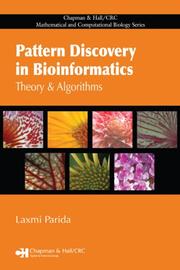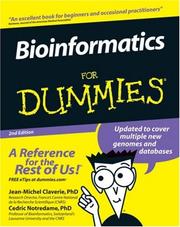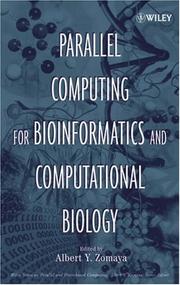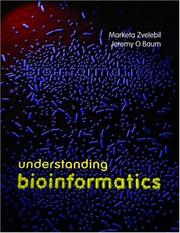| Listing 1 - 10 of 77 | << page >> |
Sort by
|

ISBN: 9780521600828 0521600820 0521840988 9780521840989 9780511806087 Year: 2006 Publisher: Cambridge Cambridge University Press
Abstract | Keywords | Export | Availability | Bookmark
 Loading...
Loading...Choose an application
- Reference Manager
- EndNote
- RefWorks (Direct export to RefWorks)
Essential Bioinformatics is a concise yet comprehensive textbook of bioinformatics, which provides a broad introduction to the entire field. Written specifically for a life science audience, the basics of bioinformatics are explained, followed by discussions of the state-of-the-art computational tools available to solve biological research problems. All key areas of bioinformatics are covered including biological databases, sequence alignment, genes and promoter prediction, molecular phylogenetics, structural bioinformatics, genomics and proteomics. The book emphasizes how computational methods work and compares the strengths and weaknesses of different methods. This balanced yet easily accessible text will be invaluable to students who do not have sophisticated computational backgrounds. Technical details of computational algorithms are explained with a minimum use of mathematical formulae; graphical illustrations are used in their place to aid understanding. The effective synthesis of existing literature as well as in-depth and up-to-date coverage of all key topics in bioinformatics make this an ideal textbook for all bioinformatics courses taken by life science students and for researchers wishing to develop their knowledge of bioinformatics to facilitate their own research.
Molecular biology --- Computer. Automation --- Bioinformatics. --- Computational Biology.

ISBN: 9781584885498 1584885491 9780429143786 Year: 2008 Publisher: Boca Raton : Chapman & Hall/CRC,
Abstract | Keywords | Export | Availability | Bookmark
 Loading...
Loading...Choose an application
- Reference Manager
- EndNote
- RefWorks (Direct export to RefWorks)
Taking a systematic approach to pattern discovery, this self-contained book supplies sound mathematical definitions and efficient algorithms to explain vital information about biological data. A solid foundation in computational methods, it explores various data patterns, including strings, clusters, permutations, topology, partial orders, and boolean expressions, to capture a different form of regularity in the data. The book focuses on models of biological sequences, including DNA, RNA, and protein sequences. With numerous exercises at the end of each chapter, it also reviews basic statistics, including probability, information theory, and the central limit theorem.
Molecular biology --- Computer. Automation --- Bioinformatics --- Pattern recognition systems --- Computational Biology --- Pattern Recognition, Automated --- methods --- Bioinformatics. --- Pattern recognition systems. --- Pattern Recognition, Automated. --- methods. --- Computational Biology - methods
Periodical
ISSN: 15455963 Publisher: New York, N.Y.
Abstract | Keywords | Export | Availability | Bookmark
 Loading...
Loading...Choose an application
- Reference Manager
- EndNote
- RefWorks (Direct export to RefWorks)
Periodicals --- Bioinformatics --- Biology --- Computational Biosciences --- Computational Biosciences. --- Information Technology. --- Life Sciences. --- Information Technology --- Life Sciences --- bio-informatica --- Biologie --- Computational biology --- Computational biology - Periodicals --- Bioinformatics - Periodicals

ISBN: 9780470089859 0470089857 Year: 2007 Publisher: Hoboken, N.J. : Wiley Pub.,
Abstract | Keywords | Export | Availability | Bookmark
 Loading...
Loading...Choose an application
- Reference Manager
- EndNote
- RefWorks (Direct export to RefWorks)
Biomathematics. Biometry. Biostatistics --- Information systems --- Bioinformatics. --- Bio-informatique. --- Computational Biology. --- Bio-informatica. --- Bioinformatique. --- Bioinformatique

ISBN: 9780471718482 0471718483 Year: 2006 Publisher: Hoboken, N.J. Wiley-Interscience
Abstract | Keywords | Export | Availability | Bookmark
 Loading...
Loading...Choose an application
- Reference Manager
- EndNote
- RefWorks (Direct export to RefWorks)
Parallel Computing for Bioinformatics is the first book to deal with the topic of parallel computing and bioinformatics. Written by renowned experts and well-reputed researchers in this emerging field, it provides an opportunity for researchers to explore the rich and complex subject of ?Bioinformatics?. The book presents case studies that deal with a variety of difficult problems in Bioinformatics and how parallel computing is used to produce better results in a more efficient manner with faster rates of computation, therefore enabling more complex bioinformatics applications and larger and richer data sets. With a mixture of algorithmics, experiments, and simulations, this title offers not only qualitative but also quantitative insights into the rich field of bioinformatics.
Book
ISBN: 9780521877954 9780511975899 9781139042550 1139042556 0521877954 9781139045193 1139045199 0511975899 1316088227 1139036327 1283193183 9786613193186 1139041789 1139038648 1139041010 9781316088227 9781139036320 9781283193184 6613193186 9781139041782 9781139038645 9781139041010 Year: 2011 Publisher: Cambridge New York Cambridge University Press
Abstract | Keywords | Export | Availability | Bookmark
 Loading...
Loading...Choose an application
- Reference Manager
- EndNote
- RefWorks (Direct export to RefWorks)
"The nervous system is made up of a large number of interacting elements. To understand how such a complex system functions requires the construction and analysis of computational models at many different levels. This book provides a step-by-step account of how to model the neuron and neural circuitry to understand the nervous system at all levels, from ion channels to networks. Starting with a simple model of the neuron as an electrical circuit, gradually more details are added to include the effects of neuronal morphology, synapses, ion channels and intracellular signalling. The principle of abstraction is explained through chapters on simplifying models, and how simplified models can be used in networks. This theme is continued in a final chapter on modelling the development of the nervous system. Requiring an elementary background in neuroscience and some high school mathematics, this textbook is an ideal basis for a course on computational neuroscience"-- "This book is about how to construct and use computational models of specific parts of the nervous system, such as a neuron, a part of a neuron or a network of neurons. It is designed to be read by people from a wide range of backgrounds from the biological, physical and computational sciences. The word 'model' can mean different things in different disciplines, and even researchers in the same field may disagree on the nuances of its meaning. For example, to biologists, the term 'model' can mean 'animal model'; to physicists, the standard model is a step towards a complete theory of fundamental particles and interactions. We therefore start this chapter by attempting to clarify what we mean by computational models and modelling in the context of neuroscience. Before giving a brief chapter-by-chapter overview of the book, we also discuss what might be called the philosophy of modelling: general issues in computational modelling that recur throughout the book"--
Multi
ISBN: 9780128156438 0128156430 9780128155530 0128155531 Year: 2019 Publisher: London
Abstract | Keywords | Export | Availability | Bookmark
 Loading...
Loading...Choose an application
- Reference Manager
- EndNote
- RefWorks (Direct export to RefWorks)
Intelligent Data Analysis for Biomedical Applications: Challenges and Solutions presents specialized statistical, pattern recognition, machine learning, data abstraction and visualization tools for the analysis of data and discovery of mechanisms that create data. It provides computational methods and tools for intelligent data analysis, with an emphasis on problem-solving relating to automated data collection, such as computer-based patient records, data warehousing tools, intelligent alarming, effective and efficient monitoring, and more. This book provides useful references for educational institutions, industry professionals, researchers, scientists, engineers and practitioners interested in intelligent data analysis, knowledge discovery, and decision support in databases.
Biomathematics. Biometry. Biostatistics --- Molecular biology --- Information systems --- Bioinformatics. --- Medical sciences --- Data mining. --- Computational Biology. --- Medicine. --- Data processing.
Multi
ISBN: 9780128144831 0128144831 0128144823 9780128144824 Year: 2020 Publisher: London San Diego, CA
Abstract | Keywords | Export | Availability | Bookmark
 Loading...
Loading...Choose an application
- Reference Manager
- EndNote
- RefWorks (Direct export to RefWorks)
Biomathematics. Biometry. Biostatistics --- Biological techniques --- Molecular biology --- Bioinformatics. --- Biomedical engineering --- Medicine --- Biomedical Engineering. --- Computational Biology --- Data processing. --- methods
Periodical
Abstract | Keywords | Export | Availability | Bookmark
 Loading...
Loading...Choose an application
- Reference Manager
- EndNote
- RefWorks (Direct export to RefWorks)
Systems biology --- Bioinformatics --- Biological systems --- Molecular biology --- Genomics --- Biosystems --- Systems, Biological --- Bio-informatics --- Biological informatics --- Systems Biology. --- Systems biology. --- Biology, Systems --- Biology --- Computational biology --- Systems Theory

ISBN: 9780815340249 0815340249 Year: 2008 Publisher: New York (N.Y.) Garland Science
Abstract | Keywords | Export | Availability | Bookmark
 Loading...
Loading...Choose an application
- Reference Manager
- EndNote
- RefWorks (Direct export to RefWorks)
Suitable for advanced undergraduates and postgraduates, "Understanding Bioinformatics" provides a definitive guide to this vibrant and evolving discipline. This book takes a conceptual approach. It guides the reader from first principles through to an understanding of the computational techniques and the key algorithms. "Understanding Bioinformatics" is an invaluable companion for students from their first encounter with the subject through to more advanced studies. This book is divided into seven parts, with the opening part introducing the basics of nucleic acids, proteins and databases. Subsequent parts are divided into 'Applications' and 'Theory' Chapters, allowing readers to focus their attention effectively.In each section, the Applications Chapter provides a fast and straightforward route to understanding the main concepts and 'getting started'. Each of these is then followed by Theory Chapters which give greater detail and present the underlying mathematics. In Part 2, Sequence Alignments, the Applications Chapter shows the reader how to get started on producing and analyzing sequence alignments, and using sequences for database searching, while the next two chapters look closely at the more advanced techniques and the mathematical algorithms involved. The Part 3 covers evolutionary processes and shows how bioinformatics can be used to help build phylogenetic trees. Part 4 looks at the characteristics of whole genomes. In Parts 5 and 6 the focus turns to secondary and tertiary structure - predicting structural conformation and analysing structure-function relationships. The last part surveys methods of analyzing data from a set of genes or proteins of an organism and is rounded off with an overview of systems biology.The writing style of "Understanding Bioinformatics" is notable for its clarity, while the extensive, full-color artwork has been designed to present the key concepts with simplicity and consistency. Each chapter uses mind-maps and flow diagrams to Give an overview of the conceptual links within each topic.
Biomathematics. Biometry. Biostatistics --- Computational Biology --- Bioinformatics --- Bio-informatique --- methods --- Bioinformatics. --- methods. --- Bioinformatica --- 57.087 --- Methods and techniques for parameter estimation. Recording of biological data --- Bioinformatica. --- 57.087 Methods and techniques for parameter estimation. Recording of biological data --- Methods. --- Bio-informatics --- Biological informatics --- Biology --- Information science --- Computational biology --- Systems biology --- Data processing
| Listing 1 - 10 of 77 | << page >> |
Sort by
|

 Search
Search Feedback
Feedback About UniCat
About UniCat  Help
Help News
News